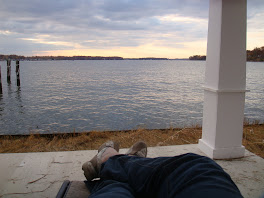I've mentioned before that we're having a new house built where our old house stood. Undoubtedly I will repeat some details. The old house was built in 1964 out of blocks that had a pale blue glaze on one side. The house needed saving or destruction when we first bought it in 1993. We saved it by doing extensive renovations and repairs. Even then we were well aware that the lot was worth more than the house, because the lot is on Annapolis's South River where it enters the Chesapeake Bay.
We didn't put a new roof on the house even though it was not long thereafter we bought it when the wind started blowing shingles off. We were planning to build a second story when we accumulated enough money, so why waste the money on a new roof? But living near the water is hard on roofs, and periodically Tom would climb on top of the house to put roofing material over the bare spots. Fortunately, the roof was simple and had a low peak, so Tom did not risk his life doing this, and he could take advantage of a great view of the water from up there.
Ultimately, wind and water took its toll on the roof and the rest of the house, with leaks especially apparent in our bedroom, where a hole steadily expanded in the cathedral ceiling, letting in insulation and cold air. The crawl space, which we had had waterproofed and was nice and dry for the first ten years or so thereafter, eventually took on water from plumbing leaks and snowfalls. Mice and raccoons also intruded. It was not unusual to see a mouse run across the floor of the family room in the evening while we were watching TV. Raccoons in the roof and under the bedroom floor would rustle around at night disturbing our sleep until we finally realized the source of the noise.
We were losing the battle to both species despite persistent trapping efforts. One raccoon trapping experience resulted in the humane capture and release of a mother and her babies (years later, the release of captured raccoons became illegal out of fear of the spread of rabies). Since we had stopped living in the house during the work week in 2002, the critters had more opportunities to execute their attack than we had to defend against it. The mice built nests in a computer printer and in a sofa, among other places, shredding paper to make them cozy. Mice poop became so common in the kitchen drawers that we took the stuff out of them and stopped using them.
The house had outlived its natural life span. Our architect determined with the help of a structural engineer that the house could not support a second floor. It was time for change. It took about two weeks to take the house down to the foundation.
Here are a few things I learned during the process of house destruction:
1. Mice do not need to taste non-natural fibers to know they don't like them. Wool items stored under the house were well-eaten, but the polyester things were untouched. I don't think they care much for granola bars, either, based on similar observations.
2. Plastic shopping bags are nearly indestructible. Many were in our crawl space and even though they got wet, they remained intact and structurally as good as new. Even the ink was stable. This is why it's important to recycle plastics rather than bury them or otherwise discard them.
3. Plastic garbage bags seem to biodegrade when wet. I guess they make them to do that. Why can't them make all plastic bags biodegradable?
4. Do not store things in cardboard if there's a risk of its exposure to water. Cardboard is biodegradable and vulnerable to attack from mold and mildew. If breakable objects are in a cardboard box that has been wet but then has dried, remove the objects before lifting the box.
5. Raccoons have a high-fiber diet and tubular-shaped poop. They enjoy watermelon but spit out the seeds.
6. Raccoons are not always as cute as commonly portrayed. A raccoon living out in the wild can look pretty scruffy.
7. Some artificial fibers seemed immune to mold, mildew, and other causes of decay. I found this especially to be the case for knit scarves and hats. These came out of the worst possible conditions looking nearly as good as new with just a slight smell of mildew as a result of exposure to less durable fabrics.
Sunday, April 25, 2010
Bringing Down the House
Labels:
Annapolis,
Anne Arundel,
Chesapeake Bay,
construction,
home building,
Maryland,
raccoons,
South River
Posted by
Jane
at
7:42 PM


Location:
Anne Arundel County, MD, USA
Subscribe to:
Post Comments (Atom)








No comments:
Post a Comment